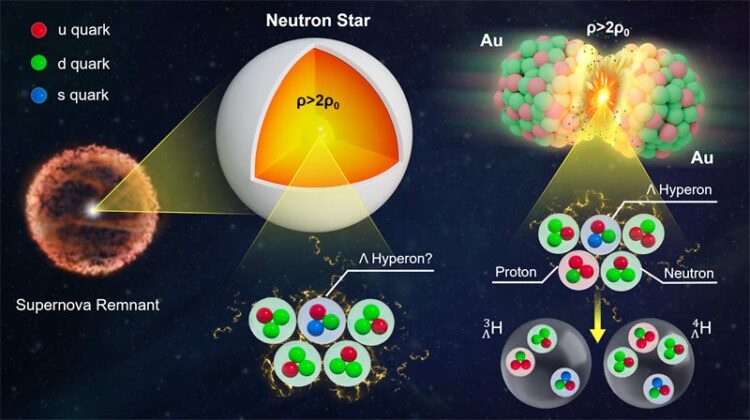Scientists observe hypernuclei collective flow in heavy-ion collisions

Neutron stars are compact objects formed when massive stars collapse at the end of their lives. Hyperonuclei collective flow in high-energy heavy ion collisions can be used to extract hyperon-nucleon interactions in the nuclear medium and understand the inner structure of neutron stars.
Image by IMP
Scientists from the Institute of Modern Physics (IMP) of the Chinese Academy of Sciences (CAS) and their collaborators in the RHIC-STAR experiment have observed the collective flow of hypernuclei in heavy-ion collisions for the first time. This achievement offers a new direction for studying hyperon–nucleon (Y–N) interactions in dense nuclear matter environments. The study was published in Physical Review Letters on May 24.
Hyperons are baryons that contain strange (s) quark, while nucleons (proton or neutron) only contain up (u) and down (d) quarks. Hyperons and nucleons can form bound states, which are called “hypernuclei.” Theoretical predictions suggest that hyperons exist in the interior of neutron stars, which are compact stars formed when supermassive stars collapse. However, the appearance of hyperons softens the equation of state of nuclear matter, thus bringing challenges to the theoretical construction of massive neutron stars. This is known as the “hyperon puzzle” in neutron star research.
Extracting the strength of the Y–N interaction in a dense nuclear medium experimentally is essential to solving the “hyperon puzzle.” Meanwhile it has great significance for understanding the theory of strong interaction, i.e., quantum chromodynamics (QCD). The collective flow of hypernuclei may be used to extract the Y–N interactions in dense nuclear matter and solve the “hyperon puzzle.”
High-energy heavy ion collisions are a unique tool for studying the properties of dense nuclear matter in the laboratory. In heavy-ion collisions, due to the pressure gradient of dense nuclear matter, particles exhibit collective flow such as directed flow and elliptic flow. Scientists have observed the collective flow of mesons, baryons and light nuclei in experiments. However, owing to the rarity of hypernuclei production, experimental data on hypernuclei collective flow has been lacking.
The experiment of this research was conducted at the Relativistic Heavy Ion Collider (RHIC) at the Brookhaven National Laboratory in the United States. Based on 3 GeV Au–Au collision data from the Solenoidal Tracker at RHIC (STAR) experiment, scientists reconstructed about 8400 hypertritons (i.e., hypernuclei consisting of a Λ hyperon, a proton and a neutron) and about 5200 hyperhydrogen-4 hypernuclei (i.e., those consisting of a Λ hyperon, a proton and two neutrons). This is the largest statistical data sample of hypertritons and hyperhydrogen-4 hypernuclei observed experimentally so far.
Scientists observed for the first time that these hypernuclei have significant directed flow. They also extracted the slopes of the directed flow of hypernuclei and light nuclei in the mid-rapidity region. They found that the slopes of light nuclei and hypernuclei follow a similar mass number scaling, indicating that the production of hypernuclei and light nuclei in heavy ion collisions could be explained by the “coalescence process.”
This work offers a new direction for studying Y–N interactions under finite pressure, which is important for making the connection between nuclear collisions and the equation of state that governs the inner structure of compact stars.
STAR is an international experimental collaboration at RHIC, composed of more than 700 researchers at 71 institutions in 14 countries. This work was led by Prof. ZHANG Yapeng’s team from IMP. Principal authors of this study include his collaborators HU Chenlu (PhD student), Dr. HE Xionghong and ZHAO Fengyi (PhD student), all from IMP, as well as Dr. DONG Xin, Dr. JI Yuanjing and Dr. LEUNG Yue-Hang, all from the Lawrence Berkeley National Laboratory in the U.S.
Journal: Physical Review Letters
DOI: 10.1103/PhysRevLett.130.212301
Article Publication Date: 24-May-2023
Media Contact
LIU Fang
Institute of Modern Physics
fangliu@impcas.ac.cn
All latest news from the category: Physics and Astronomy
This area deals with the fundamental laws and building blocks of nature and how they interact, the properties and the behavior of matter, and research into space and time and their structures.
innovations-report provides in-depth reports and articles on subjects such as astrophysics, laser technologies, nuclear, quantum, particle and solid-state physics, nanotechnologies, planetary research and findings (Mars, Venus) and developments related to the Hubble Telescope.
Newest articles

First-of-its-kind study uses remote sensing to monitor plastic debris in rivers and lakes
Remote sensing creates a cost-effective solution to monitoring plastic pollution. A first-of-its-kind study from researchers at the University of Minnesota Twin Cities shows how remote sensing can help monitor and…

Laser-based artificial neuron mimics nerve cell functions at lightning speed
With a processing speed a billion times faster than nature, chip-based laser neuron could help advance AI tasks such as pattern recognition and sequence prediction. Researchers have developed a laser-based…

Optimising the processing of plastic waste
Just one look in the yellow bin reveals a colourful jumble of different types of plastic. However, the purer and more uniform plastic waste is, the easier it is to…


